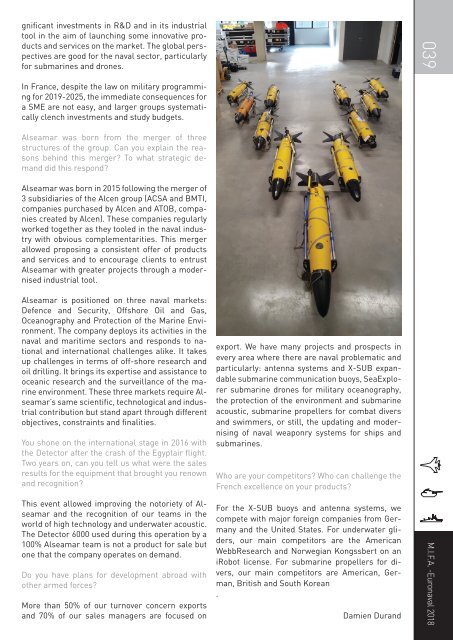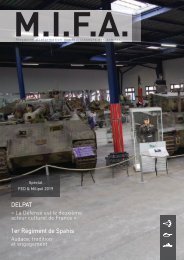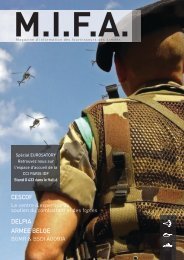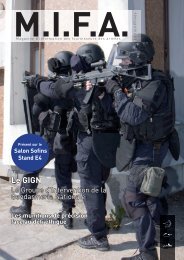Create successful ePaper yourself
Turn your PDF publications into a flip-book with our unique Google optimized e-Paper software.
gnificant investments in R&D and in its industrial<br />
tool in the aim of launching some innovative products<br />
and services on the market. The global perspectives<br />
are good for the naval sector, particularly<br />
for submarines and drones.<br />
039<br />
In France, despite the law on military programming<br />
for 2019-2025, the immediate consequences for<br />
a SME are not easy, and larger groups systematically<br />
clench investments and study budgets.<br />
Alseamar was born from the merger of three<br />
structures of the group. Can you explain the reasons<br />
behind this merger? To what strategic demand<br />
did this respond?<br />
Alseamar was born in 2015 following the merger of<br />
3 subsidiaries of the Alcen group (ACSA and BMTI,<br />
companies purchased by Alcen and ATOB, companies<br />
created by Alcen). These companies regularly<br />
worked together as they tooled in the naval industry<br />
with obvious complementarities. This merger<br />
allowed proposing a consistent offer of products<br />
and services and to encourage clients to entrust<br />
Alseamar with greater projects through a modernised<br />
industrial tool.<br />
Alseamar is positioned on three naval markets:<br />
Defence and Security, Offshore Oil and Gas,<br />
Oceanography and Protection of the Marine Environment.<br />
The company deploys its activities in the<br />
naval and maritime sectors and responds to national<br />
and international challenges alike. It takes<br />
up challenges in terms of off-shore research and<br />
oil drilling. It brings its expertise and assistance to<br />
oceanic research and the surveillance of the marine<br />
environment. These three markets require Alseamar’s<br />
same scientific, technological and industrial<br />
contribution but stand apart through different<br />
objectives, constraints and finalities.<br />
You shone on the international stage in 2016 with<br />
the Detector after the crash of the Egyptair flight.<br />
Two years on, can you tell us what were the sales<br />
results for the equipment that brought you renown<br />
and recognition?<br />
export. We have many projects and prospects in<br />
every area where there are naval problematic and<br />
particularly: antenna systems and X-SUB expandable<br />
submarine communication buoys, SeaExplorer<br />
submarine drones for military oceanography,<br />
the protection of the environment and submarine<br />
acoustic, submarine propellers for combat divers<br />
and swimmers, or still, the updating and modernising<br />
of naval weaponry systems for ships and<br />
submarines.<br />
Who are your competitors? Who can challenge the<br />
French excellence on your products?<br />
This event allowed improving the notoriety of Alseamar<br />
and the recognition of our teams in the<br />
world of high technology and underwater acoustic.<br />
The Detector 6000 used during this operation by a<br />
100% Alseamar team is not a product for sale but<br />
one that the company operates on demand.<br />
Do you have plans for development abroad with<br />
other armed forces?<br />
More than 50% of our turnover concern exports<br />
and 70% of our sales managers are focused on<br />
For the X-SUB buoys and antenna systems, we<br />
compete with major foreign companies from Germany<br />
and the United States. For underwater gliders,<br />
our main competitors are the American<br />
WebbResearch and Norwegian Kongssbert on an<br />
iRobot license. For submarine propellers for divers,<br />
our main competitors are American, German,<br />
British and South Korean<br />
.<br />
Damien Durand<br />
M.I.F.A. -<strong>Euronaval</strong> <strong>2018</strong>















